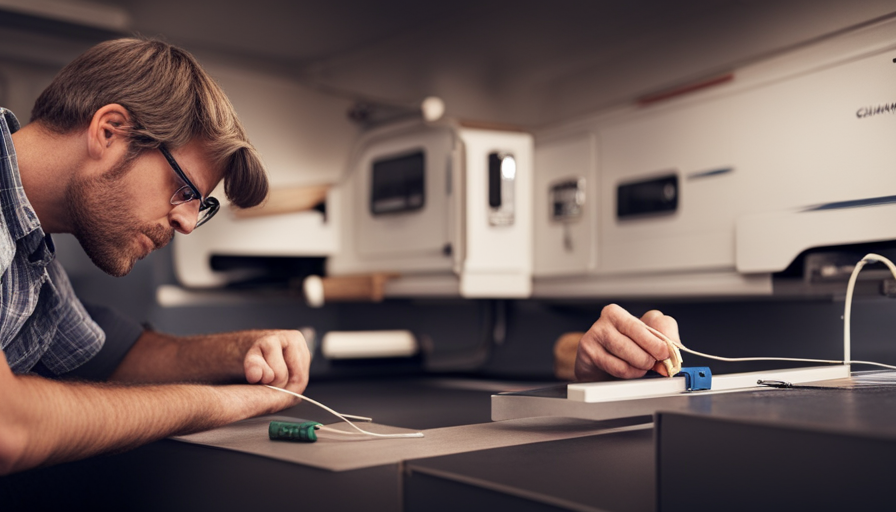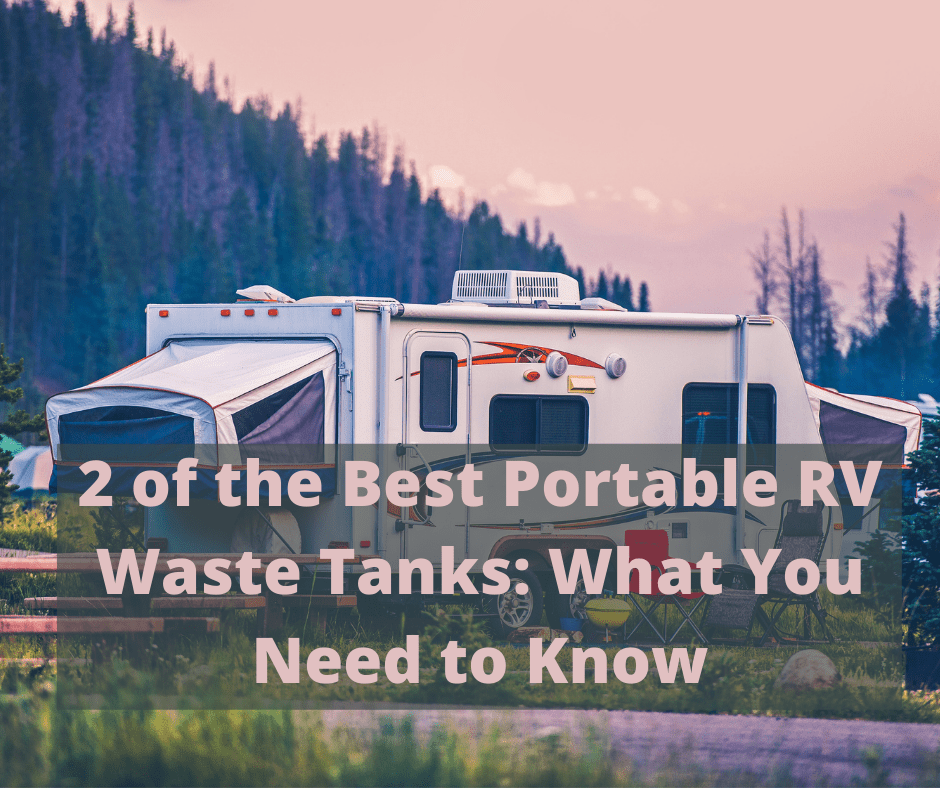You have decided to wire your camper trailer. Brace yourself for the excitement of organizing wires, decoding diagrams, and exploring the world of electricity! Don’t fret, DIY enthusiasts, as we are here to assist you in navigating the intricate process of wiring your camper trailer. Get ready for an electrifying adventure! Start exploring now!
In this precise and technical article, we will provide you with detailed instructions on how to wire your camper trailer. From assessing your electrical needs to regularly maintaining and inspecting your wiring system, we’ve got you covered.
We will take you step-by-step through the process, ensuring that you have all the necessary tools and materials, plan your wiring layout, install electrical outlets and switches, connect the battery and inverter, wire the exterior lights and brake system, and test and troubleshoot the wiring.
So grab your wire strippers, electrical tape, and a strong cup of coffee, because it’s time to delve into the electrifying world of camper trailer wiring. Let’s get started!
Key Takeaways
- Assess electrical needs and calculate power consumption of appliances and devices.
- Determine appropriate wire gauge based on length and amperage using a wire gauge calculator or chart.
- Plan wiring layout by creating a diagram and considering power requirements, outlet and switch placement, and wire length and gauge.
- Follow proper installation procedures, prioritize electrical safety, and avoid common wiring mistakes.
Assess Your Electrical Needs
Assess your electrical needs by considering the appliances and devices you plan to use in your camper trailer. Calculate power consumption by determining the wattage of each item. This information can usually be found on the appliance or in the owner’s manual.
Add up the total wattage to determine the overall power consumption. This will help you decide the size of the electrical system you’ll need for your camper trailer.
Once you’ve determined the power consumption, you can then determine the appropriate wire gauge for your electrical system. The wire gauge refers to the size of the wire and determines its ability to carry the electrical current safely. A wire gauge that’s too small can cause overheating and potentially start a fire. On the other hand, a wire gauge that’s too large can be unnecessary and increase costs.
To determine the appropriate wire gauge, you can use a wire gauge calculator or refer to a wire gauge chart. These resources will provide guidance based on the length of the wire and the maximum amperage it’ll carry. By selecting the correct wire gauge, you can ensure that your electrical system is safe and efficient.
With your electrical needs assessed and the appropriate wire gauge determined, you can now move on to gathering the necessary tools and materials for wiring your camper trailer.
Gather the Necessary Tools and Materials
First, you’ll need to make sure you have all the tools and materials required to successfully complete the task at hand. To ensure a safe and efficient wiring job for your camper trailer, here are the essential items you’ll need:
-
Choosing the right wire gauge: To handle the electrical load of your camper trailer, it’s crucial to select the appropriate wire gauge. The gauge determines the wire’s thickness and its ability to carry current. Consider the total power requirements of your appliances and lighting fixtures to determine the correct gauge size.
-
Understanding the different types of connectors: Connectors are vital for joining wires and establishing secure electrical connections. Familiarize yourself with various connectors such as butt connectors, ring terminals, and crimp connectors. Each type serves a specific purpose, ensuring a reliable and durable electrical connection.
-
Proper insulation and protection: Insulating and protecting your wiring is crucial to prevent short circuits and potential hazards. Invest in electrical tape, heat shrink tubing, and wire loom to safeguard your wires against moisture, abrasion, and other external elements.
With the necessary tools and materials in hand, you’re now ready to proceed to the next step: planning your wiring layout. This crucial phase ensures an organized and efficient installation of your camper trailer’s electrical system.
Plan Your Wiring Layout
Once you’ve gathered all the necessary tools and materials, it’s time for us to strategically map out the layout of our camper trailer’s electrical system. Design considerations play a crucial role in this process to ensure a safe and efficient wiring setup.
Start by creating a wiring diagram that outlines the entire electrical system, including the location of outlets, switches, and appliances. This diagram will serve as a blueprint for the installation and will help us identify any potential issues or conflicts.
When planning the wiring layout, it’s important to consider the power requirements of each appliance and device. Determine the optimal placement of outlets and switches based on their intended use and accessibility. Additionally, take into account the length and gauge of the wiring needed to connect each component to the main power source.
To create the wiring diagram, use electrical symbols and labels to represent each component accurately. This will make it easier to understand and follow during the installation process. Consider using software or online tools specifically designed for creating wiring diagrams to ensure accuracy and professionalism.
By carefully planning our wiring layout, we can ensure a well-organized and functional electrical system for our camper trailer.
Next, we’ll move on to the installation of the electrical outlets and switches, seamlessly integrating them into the planned wiring layout.
Install the Electrical Outlets and Switches
Now it’s time for us to bring our wiring layout to life by installing the electrical outlets and switches in our camper trailer. Before we begin, it’s important to prioritize electrical safety to avoid any accidents or damage. Make sure to turn off the power supply before working on any electrical components and wear appropriate safety gear.
To install the electrical outlets, start by locating the desired positions for them on the walls of your camper trailer. Use a stud finder to ensure you’re not drilling into any important structural elements. Once you have marked the positions, cut out the holes using a hole saw or a jigsaw.
Connect the wires from the back of the outlets to the corresponding wires in the wall using wire nuts, making sure to match the colors correctly (black to black, white to white, and green or bare copper to the ground wire).
When installing switches, follow a similar process. Determine the desired locations on the walls and cut out the holes. Connect the wires from the switches to the corresponding wires in the wall using wire nuts, ensuring proper color coding.
Common wiring mistakes to avoid include improper wire sizing, incorrect connections, and overloading circuits. It’s important to consult wiring diagrams and guidelines to ensure proper installation.
Now that we’ve installed the electrical outlets and switches, we can move on to the next step of connecting the battery and inverter.
Connect the Battery and Inverter
Let’s dive right into connecting the battery and inverter to power up your electrical system in the camper. It’s crucial to maintain the battery properly to ensure a reliable power source. Here are three key points to consider when connecting the battery and inverter:
-
Battery Maintenance: Regularly check the battery’s charge level and ensure it’s adequately topped up. Clean the battery terminals and connections to prevent corrosion, which can affect performance. Additionally, consider investing in a battery maintenance device to prolong its lifespan and optimize performance.
-
Inverter Selection: Selecting the right inverter is essential for powering your camper’s electrical appliances. Determine the total power consumption of your devices and choose an inverter that can handle the load. Consider factors such as the inverter’s wattage capacity, waveform type, and efficiency to ensure compatibility with your electrical system.
-
Proper Wiring: Follow the manufacturer’s instructions to connect the battery and inverter correctly. Ensure all connections are secure and properly insulated to prevent any electrical hazards. Use appropriate gauge wiring for the system’s voltage and length to minimize voltage drop and maximize efficiency.
Now that we’ve connected the battery and inverter, let’s move on to installing the interior lighting in the camper.
Install the Interior Lighting
Illuminate your interior oasis by installing captivating and cozy interior lighting in your mobile retreat. Choosing the right lighting fixtures is crucial to create a comfortable and inviting atmosphere inside your camper trailer. When selecting your fixtures, consider the size of your space, the type of lighting you prefer, and the power source available.
LED lights are a popular choice for camper trailers due to their low power consumption and long lifespan. They provide bright, energy-efficient lighting that enhances the overall ambiance of your living space.
Once you’ve chosen your lighting fixtures, it’s time to wire the lighting switches. Start by locating a suitable spot for your switches, ensuring they’re easily accessible. Carefully plan the wiring route to avoid any obstructions or potential hazards. Use appropriate wire sizes, connectors, and protective tubing to ensure a safe and reliable electrical connection.
Connect the positive wire from your lighting fixtures to the positive terminal of your battery or power source, and the negative wire to the negative terminal. Test the switches to make sure they’re functioning correctly before securing them in place.
Now that you’ve installed the interior lighting, it’s time to move on to the next step: wiring the exterior lights and brake system.
Wire the Exterior Lights and Brake System
To create a seamless and safe mobile retreat experience, it’s essential to connect the exterior lights and brake system of your cozy getaway. Properly wiring the exterior lights and brake system requires specific techniques and selecting the right wires.
First, you need to determine the appropriate wires for each component. For the exterior lights, you’ll need wires that can handle the electrical load and are durable enough to withstand outdoor conditions. When selecting wires for the brake system, it’s crucial to choose ones that can handle the high amperage required for braking.
Once you have the right wires, begin by connecting the exterior lights. Start by running the wires along the trailer frame, securing them with clips or zip ties. Use connectors to attach the wires to the lights, making sure to match the positive and negative terminals correctly.
When wiring the brake system, it’s important to follow the manufacturer’s instructions. Connect the wires from the brake controller to the trailer brakes, ensuring a secure and reliable connection.
To ensure everything is functioning correctly, it’s crucial to test and troubleshoot the wiring. Check each light and brake component to ensure they are working properly. If any issues arise, carefully inspect the connections and troubleshoot accordingly.
In the next section, we will explore how to test and troubleshoot the wiring to ensure a well-functioning camper trailer.
Test and Troubleshoot the Wiring
Make sure to double-check all the connections and thoroughly test the wiring to ensure that everything is in working order before hitting the road. Troubleshooting techniques can help identify and resolve common wiring issues that may arise.
One common issue is a blown fuse, which can cause a circuit to fail. To troubleshoot this, start by checking the fuse box and replacing any blown fuses with the correct amperage.
Another common problem is loose connections, which can lead to intermittent or no power. Check all the connections, making sure they’re tight and secure.
If there’s still an issue, use a multimeter to test the voltage at various points along the wiring system. This can help pinpoint the exact location of the problem.
Additionally, inspect the wiring for any signs of damage, such as frayed or exposed wires. If any damage is found, repair or replace the affected wiring.
Finally, ensure proper grounding to prevent electrical issues. You can do this by connecting the ground wire securely to a metal surface on the camper trailer.
By following these troubleshooting techniques, you can ensure that the wiring is in optimal condition for a safe and enjoyable camping experience.
Ensure Proper Grounding
After conducting a thorough test and troubleshooting session on the wiring of your camper trailer, it’s crucial to ensure proper grounding for optimal performance and safety. Grounding safety is of utmost importance in any electrical system, including the one in your camper trailer.
To ensure a secure and effective grounding connection, follow these electrical equipment guidelines:
-
Use a high-quality grounding wire: Select a wire with the appropriate gauge and make sure it’s in good condition without any fraying or damage.
-
Connect to a reliable grounding source: Identify a reliable grounding point, such as the trailer frame or a designated grounding rod, and securely connect the grounding wire to it.
-
Check for continuity: Use a multimeter to verify that there’s a continuous electrical path between the grounding wire and the grounding source.
-
Secure all connections: Make sure that all connections, including the grounding wire and the grounding source, are tightly secured to prevent any loose connections that could compromise the grounding system.
By adhering to these grounding safety guidelines and properly securing your grounding system, you can maintain a safe and efficient electrical setup in your camper trailer. Regularly maintain and inspect your wiring system to ensure its continued reliability and safety for your future travels.
Regularly Maintain and Inspect Your Wiring System
Ensure the ongoing reliability and safety of your electrical setup by regularly maintaining and inspecting your wiring system, keeping you and your loved ones safe on all your future adventures.
Conducting regular inspections of your camper trailer’s wiring system is crucial in identifying any potential issues before they become major problems. Start by visually inspecting the wiring for any signs of wear, such as fraying or exposed wires. Check all connections to ensure they’re secure and free from corrosion. Pay close attention to the junction boxes and circuit breakers, as these are common areas for problems to arise.
In addition to visual inspections, it’s recommended to hire professional help for a more thorough examination of your wiring system. A professional electrician can perform tests to ensure that your system is functioning properly and that there are no hidden issues. They have the knowledge and expertise to identify any potential hazards and make the necessary repairs or upgrades.
Regular maintenance of your camper trailer’s wiring system also includes keeping it clean and free from debris that could cause damage or interfere with proper functioning. Inspect the wires for any signs of overheating, such as discoloration or melting insulation. Clean any dirt or grime that may have accumulated on the wires or connectors.
By conducting regular inspections and seeking professional help when needed, you can ensure the ongoing safety and reliability of your camper trailer’s wiring system, providing peace of mind for all your future adventures.
Frequently Asked Questions
How do I choose the right wire size for my camper trailer?
To choose the right wire size for your camper trailer, start by calculating your power requirements. For example, let’s say you have a trailer with multiple appliances, such as a refrigerator, air conditioner, and lighting system.
Determine the total power consumption of these appliances and use a wire gauge chart to find the appropriate wire size. By considering the power needs of your camper trailer, you can ensure the safe and efficient flow of electricity throughout your vehicle.
What safety precautions should I take when working with electrical wiring?
Electrical wiring safety is paramount when working with any type of wiring. To ensure a safe environment, there are several precautions we should take.
First, always turn off the power before starting any work. Use insulated tools and wear protective gear, such as gloves and safety glasses.
Avoid common electrical wiring mistakes, such as overloading circuits or using incorrect wire sizes.
Regularly inspect and maintain your wiring to prevent potential hazards.
Can I use solar power to supplement the electrical system in my camper trailer?
Yes, absolutely! Incorporating solar power installation in our camper trailer has been a game-changer. The benefits are astounding. We no longer have to rely solely on traditional electrical systems, saving us a fortune on energy bills. The installation process involves mounting solar panels and connecting them to a solar charge controller and battery bank. This innovative solution provides sustainable, clean energy, making our adventures more eco-friendly and self-sufficient.
How do I properly connect and install a shore power hookup for my camper trailer?
To properly connect and install a shore power hookup for your camper trailer, follow these camper trailer wiring tips. First, make sure you have the correct wiring and connectors for the job.
Next, safely shut off all power sources and disconnect the battery.
Then, carefully mount and wire the shore power inlet, following the manufacturer’s instructions.
Finally, troubleshoot any electrical issues by checking connections, fuses, and circuit breakers. Remember to always prioritize safety when working with electrical systems.
What type of fuses or circuit breakers should I use in my camper trailer’s electrical system?
When choosing between fuses and circuit breakers for your camper trailer’s electrical system, it’s important to consider the specific needs and requirements of your setup.
Fuses are a reliable option that provide protection against overloading and short circuits, while circuit breakers offer the added benefit of being resettable.
However, common wiring mistakes to avoid in a camper trailer include using the wrong size fuse or breaker, inadequate grounding, and improper wire connections.
It’s crucial to consult the manufacturer’s guidelines and seek professional advice to ensure a safe and efficient electrical setup.
Conclusion
In conclusion, wiring a camper trailer requires careful planning, the right tools, and attention to detail. It’s important to assess your electrical needs, plan the layout, and install outlets and switches properly.
Connecting the battery and inverter, as well as wiring the exterior lights and brake system, are critical steps. Regular maintenance and inspections are essential for the longevity of your wiring system. Remember, "an ounce of prevention is worth a pound of cure."
So take the time to do it right and enjoy your camping adventures without electrical issues.











